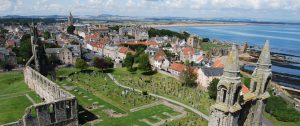
St Andrews holds a special place in Scotland’s history. It takes its name from the Apostle whose relics, legend tells us, were brought to this place in antiquity by St Rule. Scotland later adopted St Andrew as her patron saint and took his saltire cross for her flag. Before the Reformation, the town was the centre of religious life in medieval Scotland, with the bishops wielding great influence over both church and state. The ruins of its once imposing and dramatic cathedral still dominate the eastern end of the town centre.
As with many medieval centres of religious control St Andrews is also famous as a place of learning. The university, founded in 1410-11, is the third oldest in Britain. Many of its historic buildings are spread throughout the town centre and are well worth seeking out.
For many visitors, though, it’s a game that draws them here, as St Andrews is the home of golf, the sport having been played here for some 600 years. As originally played it had origins in a continental game a little like croquet. It was clearly well established here by 1457, for in that year King James II banned golf because it diverted too much time away from the much more useful pastime of archery practice. The ban seems to have been largely ignored.
The Old Course is arguably the most famous golf course in the world and the Royal and Ancient Golf Club is still the ruling body for the rules of golf. Fittingly, the Old Course hosted the Open during the millennium year and did so again in 2005, 2010 and 2015. The next staging of the Open in St Andrews is set for 2021, be sure to book your accommodation early.
St Andrews is a town meant for exploring. The medieval layout of the town centre remains intact, with the main shopping areas concentrated in Market Street and South Street, with Bell Street and Church Street connecting the two principal streets. Take time to explore – on foot – and take pleasure at the surprises and delights you will find

 01334 208330 / 07985 366103
01334 208330 / 07985 366103
